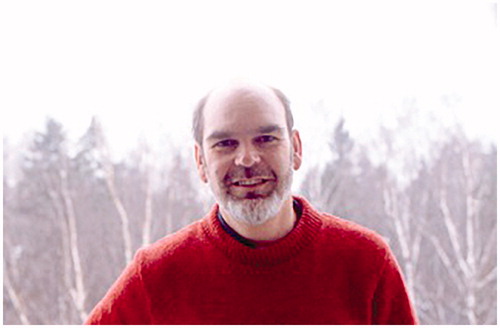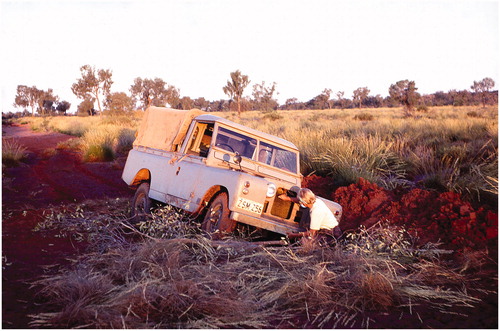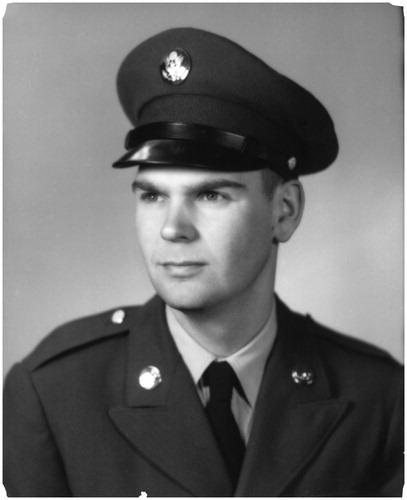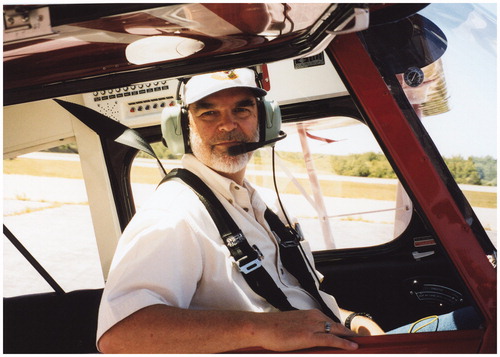Reflections from Betsy Gould
Dick was an unusual and amazing person (). He had many interests and hobbies, but I’ll remember him most for his unquenchable curiosity, his courage to try things that hadn’t been done before, and his ability to get along with all kinds of people—academics, Aboriginal custodians, and aviators, for a start. We met in the summer of 1958 when we were both 18. We were counsellors at a Presbyterian camp for children near Cincinnati. He had finished his freshman year at Harvard, and I was about to begin my college career at Bryn Mawr. I had never met anyone quite like him. He didn’t feel limited by convention, and he had an enthusiasm that was contagious. His later anthropological research reflected his sense of adventure. I sometimes felt I was just along for the ride, but what a ride it was!
Figure 1. Dick Gould at his former home in Barrington, Rhode Island, ca 2008 (Photograph: Courtesy Dick Gould).

Dick was born in Newton, Massachusetts in 1939. His father was a high school teacher who eventually became President of the State University of New York. His mother, an immigrant from Finland, was a homemaker and, later, an artist with an exquisite sense of style and colour.
At Harvard, Dick’s problem was that he had so many interests that he couldn’t decide on a major. He had read a lot of history as a teenager, and he was eager to learn from Harvard’s impressive history faculty. But he found their books more interesting than their lectures, so it was on to a biology major (chemistry knocked him out of that one), then English (the last resort of many undecided students). Finally, he discovered anthropology, and he was hooked! During the summer after his junior year, he joined a ‘dig’ at Glen Canyon in the southwestern United States, where he realised that archaeology was just what he wanted to spend his life doing.
Dick’s Army conscription and training was followed by our marriage in December 1962 (). I joined him in California while he was working towards his PhD, and together we did our first ‘ethnoarchaeological’ fieldwork among the Tolowa Indians of northern California. He would ask particularly the older women many questions, often about activities that hadn’t been practised for years, and the women would think about it and talk among themselves, and they almost always had the answers for us the next time we visited. These conversations led to Dick’s decision to dig a Tolowa archaeological site for his PhD thesis, with our Tolowa friends visiting the site often and discussing what was being found in the ground.
Dick’s first job after receiving his doctorate from Berkeley in 1965 was as Assistant Curator of North American archaeology at the American Museum of Natural History in New York. After six months at the Museum, we left for our first fieldwork in Australia. We both fell in love with this beautiful and wild country, and we returned there as often as possible over the years. The Aboriginal people we met turned out to be some of the most resourceful individuals we had ever known. Our last visit to Australia together was in 2016. Dick had spent hours organising, labelling, and digitising the hundreds of slides we had taken more than a generation earlier, and he wanted the Aboriginal custodians to have their own set of these photos. When we arrived at the community of Warburton (), where we had spent nearly two years in the 1960s and 1970s, we were astonished to learn that the older people remembered who we were and even pointed out locations where some event involving us had taken place! It was a nostalgic and mind-boggling visit!
Figure 3. Bogged—Betsy Gould, Warburton area, Western Australia, late 1960s (Photograph: Dick Gould).

Dick accepted a job at the University of Hawaii in 1971. He was happy with his work at the Museum, but he wanted to teach. He always says he learned to teach at UH. There were so many distractions—glorious weather and beautiful beaches—that it took interesting lectures to get students to come to class and resist the temptations of the outdoors. He also began his career as teller of awful jokes in class at Hawaii.
When we moved to New England in 1981, Dick continued his teaching career, joining the Anthropology Department at Brown University. His interests expanded to include farming in Finland, and later underwater archaeology and forensic anthropology. I joined him for the Finnish adventure, but by then I was moving on to other interests, namely, demography. Besides, the mosquitos in Finland were even worse than the flies in Australia and even more aggressive.
Following Dick’s retirement from Brown in 2009, we returned to our home in Honolulu to begin the next chapter in our lives. Dick engaged in vigorous outreach teaching programs and his all-consuming hobby flying and anything connected with aeroplanes (). He bought his first aeroplane while we lived in New England; his second aeroplane was an aerobatic Citabria (‘airbatic’ spelled backwards). He spent many happy hours doing loops, rolls, and spins in his Citabria, sometimes with a terrified graduate student in the back seat. The last plane that Dick owned was an Aeronca 7EC ‘Champ’.
When Dick learned that his cancer was inoperable, he was amazingly calm. He had enough time to tie up loose ends. He sold his aeroplane and cleared out his hangar; he found homes for many of his books; and he wrote to mentors and friends to thank them for their part in his life. And he said to them, ‘Please don’t be alarmed. I am not fearful about what lies ahead. My life experiences have prepared me well.’
Summary of academic positions and research themes
Richard Gould completed undergraduate studies in Anthropology at Harvard College with a BA cum laude awarded in 1961. He continued graduate studies in Anthropology at the University of California, Berkeley with the PhD awarded in 1965. His PhD thesis involved an ethnoarchaeological study examining cultural continuity and change among the Native American Tolowa of northern California (Gould Citation1965, Citation1966a, Citation1966b). Professional employment commenced with a curatorial position in North American Archaeology at the American Museum of Natural History in New York (1965–1971). During this time, Margaret Mead was a dominant figure at the museum as Curator of Ethnology (1925–1969) and provided mentorship to younger colleagues. This dynamic learning environment played an integral role in the ongoing development of Gould’s anthropological and scientific approaches to archaeological theory and practice. Following the museum appointment, Gould accepted an academic position in the Department of Anthropology at the University of Hawaii, Honolulu (Associate Professor 1971−1974; Professor 1975−1981), and then returned to the mainland and New England in 1981 as Professor of Anthropology at Brown University in Providence, Rhode Island (1981–2009).
Gould made significant contributions to the application of anthropological and scientific methods to the development of archaeological theory and method associated with a wide range of areas in archaeology (Gould Citation2011). He was a fieldwork director associated with one of the earliest large cultural resource management (CRM) projects in the USA - the 8-year Glen Canyon salvage project which commenced in 1957. This project involving the National Park Service and University of Utah provided the impetus for the development of the archaeological profession of Cultural Resource Management in North America. He played a primary role in the development of Ethnoarchaeology (Gould Citation1968a, Citation1969a, Citation1969b, Citation1971, Citation1977a, Citation1977b, Citation1978a, Citation1978b, Citation1980; Gould and Yellen Citation1987), Modern Material Culture Studies (Gould and Schiffer Citation1981; Gould and Potter Citation1984), Experimental Archaeology (Crabtree and Gould Citation1970; Gould Citation1976; Gould and Saggers Citation1985), Maritime and Underwater Archaeology (Gould Citation1983, Citation2000a, Citation2000b), and Disaster Archaeology (Gould Citation2007, Citation2011).
Desert contributions
Gould’s research in the arid interior of the Australian continent provides an early emphasis on arid-land adaptations at a time when a majority of Australian prehistoric archaeology focussed on coastal sites and adaptations. Examples of this research include the ethnoarchaeological fieldwork conducted by Dick and Betsy Gould and subsequent excavations at Puntutjarpa Rockshelter in the Warburton Ranges region of the Western Desert (Western Australia) and later excavations at James Range East in the Central Desert (Northern Territory) (Gould Citation1968a, Citation1968b, Citation1977c, Citation1984, Citation1991; Saggers Citation1982, Citation1984).
Dick’s excavations at Puntutjarpa Rockshelter not only yielded significant evidence of Aboriginal lives in the Arid Zone, but was one of the early, substantive, well documented archaeological assemblages lodged with the Western Australian Museum. Re-analysis of the faunal assemblage has proven valuable in reappraising desert lives and ecosystems and recent re-excavation and use of some of Gould’s charcoal samples from the WAM collections has changed the interpretations of the site. Gould’s use of a light aircraft for regional reconnaissance was an innovative feature of his work. In Central Australia he used aerial survey to focus an extensive ground survey by Lewis Kyle Kapton, Alan Albee and Karl Hutterer, which led to his excavations at James Range East (intirtekqerle) from 1973–1974. This wide-ranging arid zone work laid many of the foundations for new syntheses and critiques of the nature of the adaptations and deep antiquity of desert peoples in Australia (Hiscock Citation1988; Smith Citation1988; Veth Citation1989).
Whilst Gould was working with the Ngaanyatjarra in the Western Desert he recorded detailed ethnographic records of their subsistence diet. A scrutiny of recorded Australian Aboriginal traditional diets in the 1990s identified four studies which researchers considered represented diets of people living close to a traditional lifestyle, despite having been recorded in the recent past (Cane Citation1984; Gould Citation1980, Citation1986; McArthur Citation1960). Although all four records are incomplete, they represent unique and valuable records of Australian traditional diets that are unlikely to be repeated.
With the Western Australian Museum’s new CBD site opening to the public in late 2020, Richard Gould’s contribution to identity-making is reinforced through use of the ‘ethnographic’ items and images he deposited at the museum. Not only will these treasures feature in galleries, some of them stimulate a resurgent artistic endeavour in the desert. This seems an appropriate acknowledgement of the intellectual generosity of Dick, a long time Honorary Associate of the Western Australian Museum.
Innovation in maritime and underwater archaeology
Gould pioneered anthropological explanatory frameworks in the systematic study of shipwrecks globally with edited and sole-authored volumes receiving major uptake and stimulating new debates (e.g. Gould Citation1983, Citation2000a). Australia already had impeccable leadership in maritime archaeology research and cultural heritage management, through the WA Maritime Museum, its training networks and the national historic shipwreck legislation; however social science and mainstream archaeology programs, increasingly, were to adopt these behavioural approaches through time.
Disaster archaeology after the twin towers
Due to Dick’s long-term association with New York City, the tragic events of September 11, 2001 had a major impact on him personally and professionally. His development of Disaster Archaeology emerged from experiences associated with archaeological surveys, excavations, and ethnoarchaeological fieldwork in the vicinity of the World Trade Centre (Gould Citation2002a) and at a West Warwick, Rhode Island nightclub that was involved in a major internal fire (Gould Citation2004). Gould established a Forensic Archaeology Recovery Group (FAR) for the New England and Northeast Corridor region, U.S.A. to ‘assist the authorities at mass-casualty scenes in finding, recording, and recovering personal effects and human remains for purposes of victim identification and for the return of these items to victim’s families’ (Gould Citation2004:6).
Coda
Many scholars have already penned their own reflections on Dick’s contributions to their intellectual and professional lives. These include Brown Faculty colleague Douglas Anderson, who notes that Dick developed three career pathways, in each of which he become a leading figure; ethnoarchaeology, the anthropology of shipwrecks; and disaster archaeology. Anthropologist Sherry Saggers’ PhD Materialism and archaeological experimentation: testing the exotic stones hypothesis in the Central Desert of Australia and subsequent publications were strongly influenced by Dick’s thinking. Donald Pate traces Dick’s support for his Masters on Roonka and his PhD at Brown (Pate Citation1984; Pate et al. Citation1991). The maritime archaeologist David Conlin notes the impact of Shipwreck Anthropology (Gould Citation1983) and then underwater work in the Dry Tortugas of Florida (Gould Citation1993) and the waters surrounding Bermuda (Gould Citation1989, Citation2002b), leading to a joint publication (Gould and Conlin Citation1999). Charles Dortch - founding archaeology curator at the WA Museum - praises Gould’s landscapes approaches to archaeology, ethnoarchaeology and the submerged relics of the continental shelf. Finally, WA Maritime Museum archaeologist Michael McCarthy notes the profound contributions Richard made to teaching courses at the Curtin-hosted postgraduate maritime archaeology course, as well as contributions to teaching and Higher Degree programs at both Flinders and James Cook Universities.
These reflections and more detailed comments on the intellectual and professional contributions of Richard Gould, from a range of global scholars, students and colleagues, will appear in a forthcoming paper (Pate et al. Citationin prep).
Archaeology, Flinders University, Adelaide, Australia
[email protected]
Peter Veth
Archaeology, UWA and Oceans Institute, Indian Ocean Marine Research Centre, The University of Western Australia, Crawley, WA, Australia
Moya Smith
Anthropology and Archaeology, Western Australian Museum, Welshpool DC, WA, Australia
References
- Cane, S. 1984 Desert Camps: A Case Study of Stone Artefacts and Aboriginal Behaviour in the Western Desert. Unpublished PhD thesis, Department of Prehistory, Research School of Pacific Studies, Australian National University, Canberra.
- Crabtree, D.E. and R.A. Gould 1970 Man’s oldest craft recreated. Curator: The Museum Journal 13(3):179–198.
- Gould, R.A. 1965 An Introduction to Tolowa Prehistory: Archaeology and Ethnology Along the Northwestern California Coast. Unpublished PhD thesis, Department of Anthropology, University of California, Berkeley, California.
- Gould, R.A. 1966a Archaeology of the Point St. George Site and Tolowa Prehistory. Berkeley: University of California Press.
- Gould, R.A. 1966b The wealth quest among the Tolowa Indians of northwestern California. Proceedings of the American Philosophical Society 110(1):67–89.
- Gould, R.A. 1968a. Living archaeology: The Ngatatjara of Western Australia. Southwestern Journal of Anthropology 24(2):101–122.
- Gould, R.A. 1968b Preliminary report on excavations of Puntutjarpa Rockshelter, near the Warburton Ranges, Western Australia. Archaeology and Physical Anthropology in Oceania 3(3):161–185.
- Gould, R.A. 1969a Subsistence behaviour among the Western Desert Aborigines of Australia. Oceania 39(4):253–274.
- Gould, R.A. 1969b Yiwara: Foragers of the Australian Desert. New York: Charles Scribner's Sons.
- Gould, R.A. 1971 The archaeologist as ethnographer: A case from the Western Desert of Australia. World Archaeology 3(2):143–177.
- Gould, R.A. 1976 A case of heat treatment of lithic materials in aboriginal northwestern California. The Journal of California Anthropology 3(1):142–144.
- Gould, R.A. 1977a The archaeologist as ethnographer. In S. Tax and L.G. Freemen (eds), Horizons of Anthropology, pp. 151–170. Chicago: Aldine.
- Gould, R.A. 1977b Ethno-archaeology; or, where do models come from? In R.V.S. Wright (ed.), Stone Tools as Cultural Markers, pp.162–168. Canberra: Australian Institute of Aboriginal Studies.
- Gould, R.A. 1977c Puntutjarpa Rockshelter and the Australian Desert Culture. New York: American Museum of Natural History.
- Gould, R.A. (ed.) 1978a Explorations in Ethnoarchaeology. Albuquerque: University of New Mexico Press.
- Gould, R.A. 1978b The anthropology of human residues. American Anthropologist 80(4):815–835.
- Gould, R.A. 1980 Living Archaeology. Cambridge: Cambridge University Press.
- Gould, R.A. 1984 Rock pools and desert dances. Natural History 93(3):62–70.
- Gould, R.A. 1986 To have and have not: The ecology of sharing among hunter-gatherers. In N.M. Williams and E.S. Hunn (eds), Resource Managers: North American and Australian Hunter-Gatherers, pp.69–98. Canberra: Australian Institute of Aboriginal Studies.
- Gould, R.A. 1989 H.M.S. Vixen: An early ironclad ram at Bermuda. Bermuda Journal of Archaeology and Maritime History 1:43–80.
- Gould, R.A. 1991 Arid-land foraging as seen from Australia: Adaptive models and behavioural realities. Oceania 62(1):12–33.
- Gould, R.A. 1993 Bird Key Harbor Wreck (FOJE 029) 1990 fieldwork. In L. Murphy (ed.), Dry Tortugas National Park, pp.333–351. Santa Fe: National Park Service.
- Gould, R.A. 2000a Archaeology and the Social History of Ships. Cambridge: Cambridge University Press.
- Gould, R.A. 2000b Beyond exploration: Underwater archaeology after the year 2000. Historical Archaeology 34(4):24–28.
- Gould, R.A. 2002a WTC archaeology: What we saw, what we learned, and what we did about it. The SAA Archaeological Record 2(5):11–17.
- Gould, R.A. 2002b The wreck of the ‘North Carolina’, New Year’s Day, 1880. Bermuda Journal of Archaeology and Maritime History 13:28–56.
- Gould, R.A. 2004 Disaster archaeology at the West Warwick, Rhode Island nightclub fire scene. The SAA Archaeological Record 4(1):6–11.
- Gould, R.A. 2007 Disaster Archaeology. Salt Lake City: University of Utah Press.
- Gould, R.A. 2011 From living archaeology to disaster archaeology. Ethnoarchaeology 3(2):187–202.
- Gould, R.A. and D.L. Conlin 1999 Archaeology of the barrel wreck, Loggerhead Reef, Dry Tortugas National Park. The International Journal of Nautical Archaeology 28(3):207–228.
- Gould, R.A. and J.E. Yellen 1987 Man the hunted: Determinants of household spacing in desert and tropical foraging societies. Journal of Anthropological Archaeology 6(1):77–103.
- Gould, R.A. and M.B. Schiffer (eds) 1981 Modern Material Culture: The Archaeology of Us. New York: Academic Press.
- Gould, R.A. and P.B. Potter, Jr. (eds) 1984 Toward an Ethnoarchaeology of Modern America. Providence: Department of Anthropology, Brown University.
- Gould, R.A. and S. Saggers 1985 Lithic procurement in Central Australia: A closer look at Binford's idea of embeddedness in archaeology. American Antiquity 50(1):117–136.
- Gould, R.A. (ed.) 1983 Shipwreck Anthropology. Albuquerque: University of New Mexico Press.
- Hiscock, P. 1988 Prehistoric Settlement Patterns and Artefact Manufacture at Lawn Hill, Northwest Queensland. Unpublished PhD thesis, Department of Anthropology and Sociology, School of Social Science, University of Queensland, St Lucia.
- McArthur, M. 1960 Food composition and dietary levels of groups of Aborigines living on naturally occurring foods. In C.P. Mountford (ed.) Records of the American-Australian Scientific Expedition to Arnhem Land, Vol. 2, pp.90–135. Melbourne: Melbourne University Press.
- Pate, F.D. 1984 Mortuary Practices and Paleodiet as Archaeological Signatures of Social Organization and Status at Roonka on the Lower Murray River of South Australia. Unpublished MA thesis, Department of Anthropology, Brown University, Providence, Rhode Island.
- Pate, F.D., J.T. Hutton, R.A. Gould and G.L. Pretty 1991 Alterations of in vivo elemental dietary signatures in archaeological bone: Evidence from the Roonka Flat Dune, South Australia. Archaeology in Oceania 26(2):58–69.
- Pate, F.D., P. Veth, M. Smith, D. Anderson, S. Saggers, D. Conlin and P. Smith in prep. Remembering Dick Gould and his significant contributions to the development of archaeological theory and method.
- Saggers, S. 1982 Comparative analysis of adzes from Puntutjarpa Rockshelter and the James Range East site complex, Australia. Archaeology in Oceania 17(3):122–126.
- Saggers, S. 1984 Materialism and Archaeological Experimentation: Testing the Exotic Stones Hypothesis in the Central Desert of Australia. PhD thesis, Department of Anthropology, Brown University, Providence, Rhode Island.
- Smith, M. 1988 The Pattern and Timing of Prehistoric Settlement in Central Australia. Unpublished PhD thesis, Department of Archaeology and Palaeoanthropology, University of New England, Armidale.
- Veth, P.M. 1989 Islands in the Interior: A model for the colonisation of Australia's arid zone. Archaeology in Oceania 24(3):81–92.


